Rachel Tropea is Senior Research Archivist at the University of Melbourne and and attended PASIG2019 with support from the DPC's Leadership Programme which is generously funded by DPC Supporters
This is the second of two blog posts about PASIG2019 held at El Colegio de México in Mexico City. In the previous post I looked at the history and organisation of Preservation and Archiving Special Interest Group Meeting (PASIG), and in this post I summarise the content of select presentations.
There is a broadening scope of professionals and skill sets that are included under the umbrella of ‘digital preservation’ and this was reflected at PASIG, both in the presentations and in the list of attendees. The overriding theme of the conference was that people, values, politics, policies and resources are integral to and intertwined with the technical components of the infrastructure landscape.
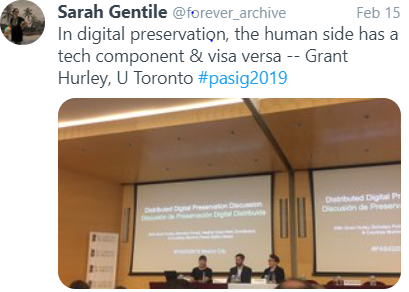
According to the organisers and participant feedback, storage trends, cloud trends, the need to better understand the vendor and service provider landscape, and the economics of digital preservation were popular themes at PASIG2019. People appreciated real life case studies, stories of failure and overcoming problems, of building a business case, and the application of project management methodologies. I have a predilection for methodologies underpinned by a social justice imperative, and ethical, consultative frameworks. I’m also very interested in practical applications of technologies, workflows, standards etc. which empower users in multiple environments. Below I give a recap of four presentations based on some of these themes.
Keynote: Carlos Martínez Suárez, Video Tropico Sur
Carlos Martínez Suárez gave a very moving keynote presentation about documenting human rights abuses of independent communities in Chiapas and the role of institutional archives in preserving such content. Carlos has built an archive over decades of 2500 valuable photos, negatives and video. He spoke of the trust the community has placed in him and was very emotional when he spoke about the deep and lasting friendships he has with Chiapas farmers, the value of human exchange of knowledge and things that have been lost: “I am not afraid of showing my emotions” he said. The highly political nature of the content has meant that the government archives he approached were not interested in housing the archive, and it took a personal connection with archivist Natalie Baur at Collegia de Mexico for preservation work on this collection to commence. The tensions and the moral and ethical questions raised by this archive and presentation (which included live footage of very personal testimony) were reflected in T-Kay Sangwand’s tweet at the time “these videos are incredible but also i feel uncomfortable watching them, esp the funeral rituals. i feel too much like a national geographic spectator… but wow also amazing to see chiapas around the time of the 1994 zapatista uprising” (@tttkay, Feb 14, 2019, Tweet). Natalie Baur is working the Carlos Suárez and the Chiapas community on an archival program for the collection.
Ethics Politics of Preservation. Community Archives: Nancy Godoy (Arizona State University), Veronica Reyes-Escudero (University of Arizona)

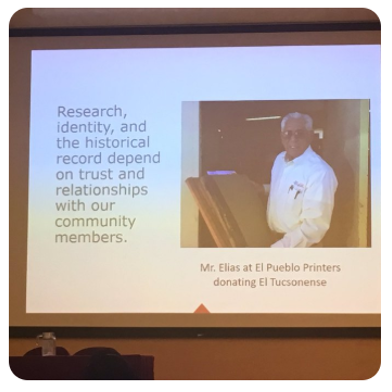 Veronica Reyes-Escudero, Slide: “Research, Identity…”, shown on February 15, 2019
Veronica Reyes-Escudero, Slide: “Research, Identity…”, shown on February 15, 2019
at Preservation and Archiving Special Interest Group conference (PASIG2019).
Nancy Godoy and Veronica Reyes-Escudero stressed the importance of human relations in their talks about engaging with, educating and empowering communities to develop archival programs for their collections. Veronica Reyes-Escudero, Borderlands Curator at ASU spoke about her social justice education project The Documented Border: An Open Access Digital Archive and the struggle to systematically document the under-documented. Veronica hopes that this archive will advance understanding and awareness about the people living and working along the major farming land that stretches along the U.S.-Mexican border. Citing post-custodial archival theory and community archiving as foundational to her work, Veronica spoke of the role of cultural competency as a tool for front-end digital preservation, and in building authentic relationships and trust with marginalised communities.
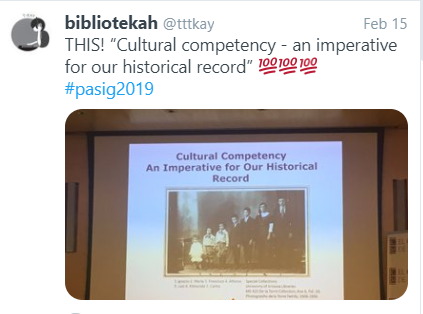
For more information, see Veronica’s book “Latinos in Libraries, Museums, and Archives”. It’s worth mentioning that Verónica “gave up her weekly family day with her small child to write this book” (@laurenbgood, Feb 14, 2019, Tweet).
Nancy Godoy (Arizona State University) is an archivist for the largest Chicana/o archives in Arizona. She supports community archival efforts by bringing in more Latino/a collections to the University Archives, as well as educating communities in archival practice. Nancy spoke about reimagining archives not as a static repository but “as an active site of knowledge production”. She began exposing some of the strongest prevailing myths in archives and history which have contributed to the oppression and marginalisation of Latino/a people. In archives, it’s the myth of neutrality: “As archivists we're trained to be neutral and passive; I want to talk about how we can break that harmful practice”. In history, the romanticized wild west narrative of the US is harmful, it eliminates and dehumanizes the Latino/a population who have lived in Arizona well before Anglo “settlement”. “The myth is strong, I fight it every day at my work.”
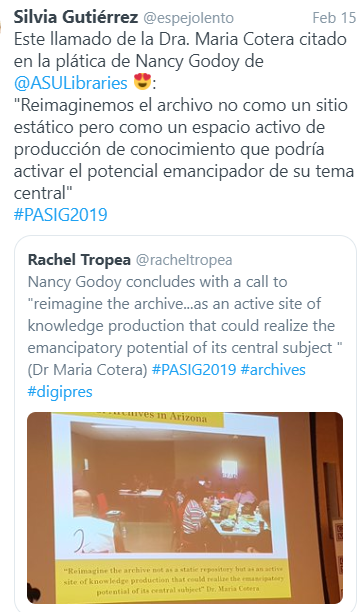
Nancy stated that "before we think about digital preservation, we need to think about community empowerment." Her training and education efforts teach people to become community archivists so that they have the knowledge and tools to become “agents of change” in the archives. “[People] often do not recognise the value of their collections because of past erasure. We watched a video of a donor who Nancy had spent two years building a relationship with: "Nancy pointed at the shelves and said "Your father belongs here. That meant so much to me...there had been attempts to erase my father's history'”. Nancy runs Oral History days, Archives and Preservation workshops for marginilised communities. She does “not expect people to come to the University because this is a barrier”. Other tips from Nancy for holding community archives workshops: provide refreshments; give out resource toolkits (Nancy has a ‘archives starter kit’), boxes, folders, mylar, gloves, and run them regularly.
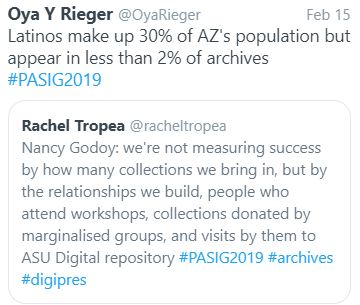
When ASU does community archives days, the University does not ask for anything in return from participants. Rather, they wish to share their expertise as archivists, knowledge that has traditionally excluded people from archives. On twitter one audience member expressed a concern held by many of us who commit to or make promises to people with whom we’ve built strong relationships based on trust: “My question is: how do you know when your institution has your back when it comes to making commitments to marginalized communities? There can be a lot of lip service, but not follow through” (T-Kay Sangwand, Tweet, Feb 15, 2019). According to Nancy, she never stops fighting. See Nancy Godoy’s presentation slides: https://pasig.figshare.com/articles/Engaging_Educating_and_Empowering_Developing_Community-Driven_Archival_Collections/7795859
Building capacity through assessment: Frances Harrell (NEDCC)
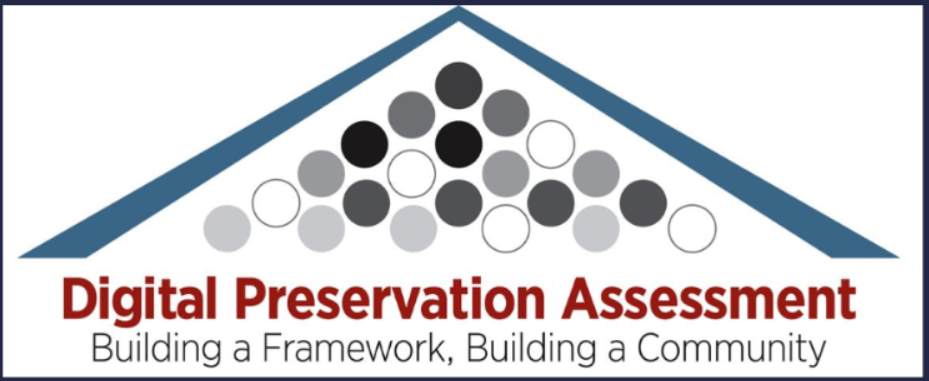
Frances Harrell from the Northeast Document Conservation Center (NEDCC) presented on history and development of the collaborative Digital Preservation Assessment training program. The program approaches digital preservation assessment and training through case-study assessments, shadowing opportunities, workshops, a training institute, and a final symposium.
NEDCC worked with other Regional Alliance for Preservation (RAP) centers, digital preservation practitioners and educators to develop a framework for identifying and assessing core elements of digital preservation practice. The framework was piloted at four institutions and at the same workshops were offered on Digital Preservation Peer-Assessment procedures. In July 2018 the Digital Preservation Assessment Training Institute trained a group of 12 assessors who then each performed an assessment as part of the program. The final assessment framework, workshop curriculum and more information about the project are available online, see https://www.nedcc.org/preservation-training/digital-preservation-assessment-training
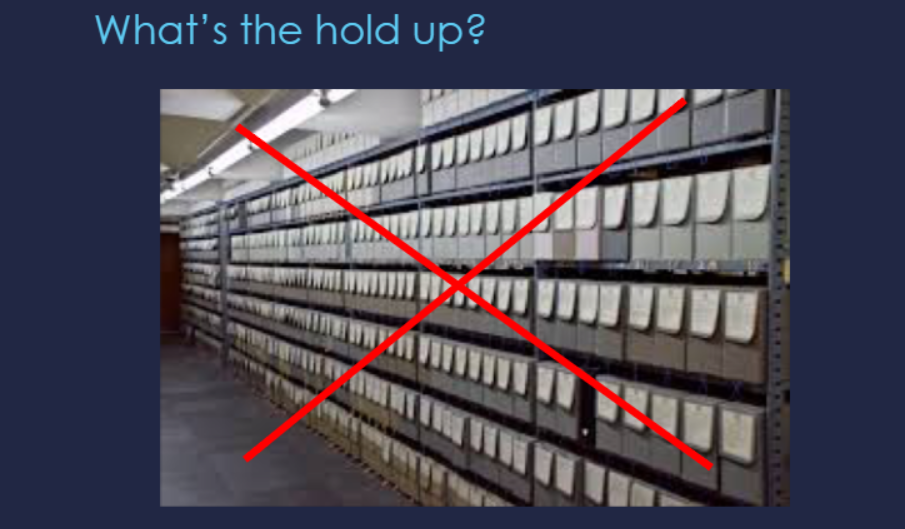
Frances Harrell, “What’s the hold up?”, Presentation Slide, PASIG2019, 15 February 2019
The assessment template in the Digital Preservation Peer Assessment handbook, available online at https://www.nedcc.org/assets/media/documents/nedcc-DPA-Peer-3.19-web3.pdf provides questions to prompt staff at cultural heritage institutions to think critically about their digital preservation activities. The goal of the assessment is to help an institution document their digital preservation successes, recognize where they need to grow and identify challenges that stand in the way of that growth. It can also help an institution to create a digital preservation plan. It “is framed as a peer assessment, rather than a self-assessment, to encourage institutions to work in pairs or groups to benchmark their program and progress. This model provides an outside perspective on the institution, guidance for improvement from colleagues, and a partner or cohort for accountability” (Digital Preservation Peer Assessment handbook, p.3). A basic understanding of digital preservation is a desirable but not essential prerequisite, and the assessment can be used by institutions at any phase of their digital preservation efforts. See Frances’s slides: https://pasig.figshare.com/articles/Building_capacity_through_assessment/7795844
Positioning PASIG2019 in Mexico gave the global south a presence and a voice in the digital preservation landscape. It also brought to the fore the impact of cultural and ideological differences and economic disparity between regions. As Oya Rieger points out in her reflections on the conference:
“[The digital preservation community] is growing in diversity. This is a huge strength but also a pressure point in terms of building a common language, being able to communicate, and identifying priorities and common themes… [On the values of diversity, inclusivity, social justice]: Only a handful of organisations have the resources and service infrastructure to do ‘due justice’ to digital preservation. I am really proud of our communities and how much advancement we’ve made…but I’m also seeing a widening gap between haves and have-nots.”[1]
The widening gap is one of the moral challenges facing the digital preservation community. However with the right mechanisms in place, and underpinned by values of social justice and inclusivity, PASIG (and iPres) are ideal forums where these thorny issues can be worked through.
I am very grateful to the Digital Preservation Coalition (DPC) for supporting my trip to the conference through the Leadership Programme scholarship scheme. Thanks also to the wonderful hosts at El Colegio de México and Art Pasquinelli for his kindness and hospitality.
[1] https://www.youtube.com/watch?v=0qTYOftUb2E&feature=youtu.be































































































































Read more...